TRADITIONS OF OAXACA
Traditions of OAXACA
In the state of Oaxaca there are many customs and traditions throughout the year, and within the state, said that they have the same purpose of celebration but with different things, in fact from one region to another or even more from one town to another, the Customs vary for perhaps details but that is what makes them authentic.
All the holidays are celebrated, the profane and the religious ones. The festival calendar is extensive due to the diversity of ethnic groups, which they still conserve. Oaxaca has a combination in its traditions of the culture of the ancestors and the current culture, a state that does not lose its customs, adapts them to new times and needs.
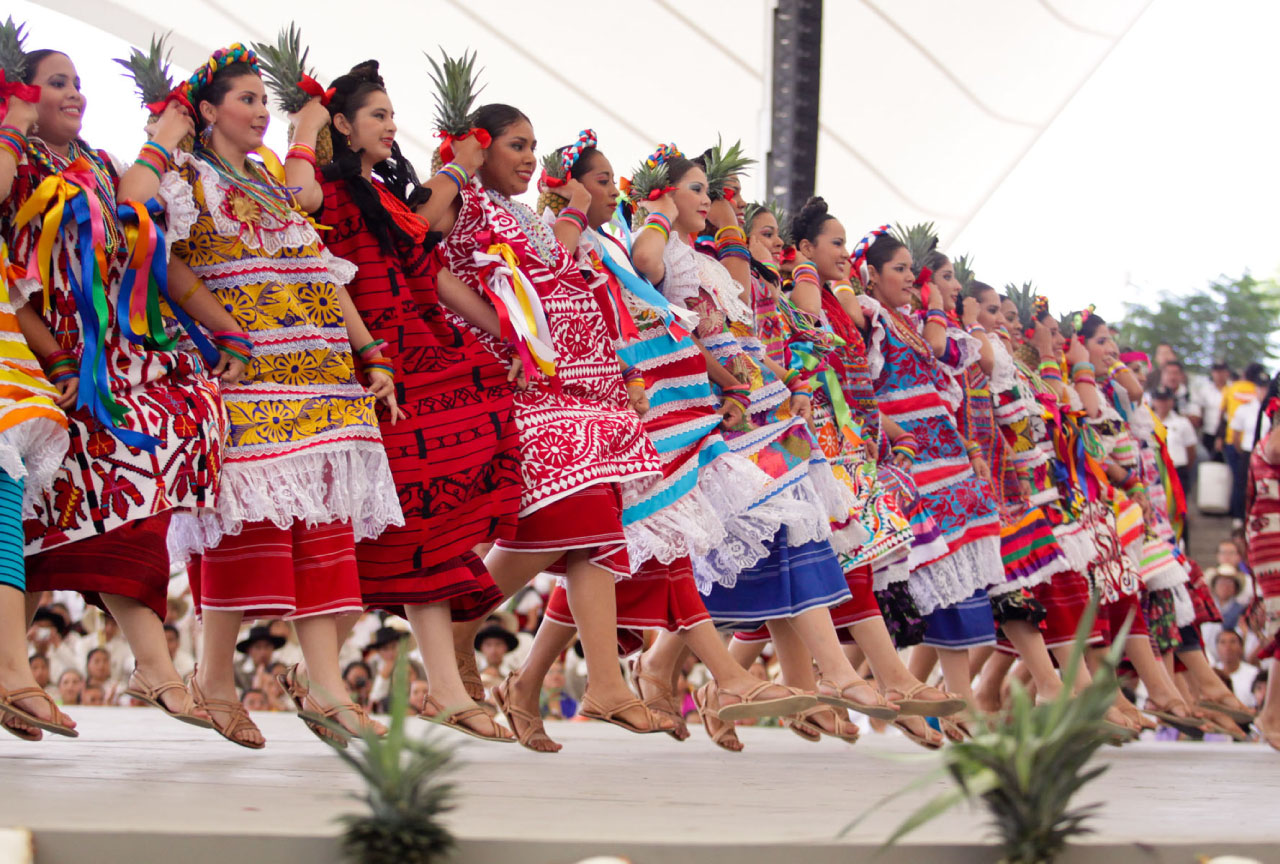
LA GUELAGUETZA
Monday of the hill in the city of Oaxaca. La Guelaguetza is one of the most important traditions in Oaxaca. Its name is derived from the Zapotec word “Guendalezaa” which means “offering, present, fulfillment.” This festival is a great ethnic and cultural mosaic that is expressed in multiple languages, dances, songs, dresses and customs of the Oaxacan people. The celebration has acquired world renown and has the participation of the eight folkloric regions of the State: La Costa, La Cañada, La Mixteca, La Sierra Norte, Sierra Sur, Papaloapan, El Istmo and Los Valles Centrales.
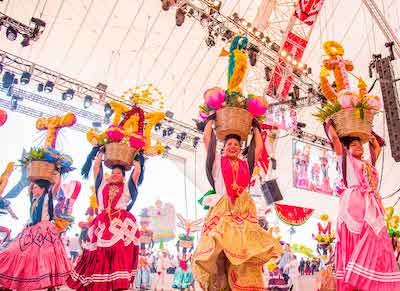
In an auditorium in the Cerro del Fortín, they offer their main traditional dances and dances, along with characteristic products of their land such as fruits or handicrafts. The festivities include other shows starting with the parade of the delegations organized in the manner of the traditional Calenda. In the same auditorium where the Guelaguetza takes place, the Legend of Princess Donají, daughter of the Zapotec King Cosijoezay of Princess Coyolicatzin, is presented, a presentation full of drama, light, sound and fireworks.
The festival is complemented with gastronomic and handicraft samples, traditional representations of the most diverse communities in the state, exhibitions, concerts and cultural events.
La Guelaguetza is celebrated every year on the two Mondays after July 16, except when the first Monday falls on July 18, Benito Juárez’s death anniversary. In that case, the celebrations are postponed for a week.
The venue for the celebration is the Guelaguetza Auditorium where various art, dance, music and theater events take place throughout the year. This enclosure is located in Cerro del Fortín and was built of green quarry. Its semicircular design reminiscent of ancient Greek theaters, takes advantage of the slope of the land to place the stands. Although the auditorium has a canvas roof, it is recommended to bring sun protection and a hat. It has a capacity of 11,000 spectators and has a beautiful view of the City of Oaxaca and the Valleys.
NIGHT OF RADISHES
The tradition of the Night of Radishes dates back to colonial times, when the indigenous people learned to harvest large radishes that were produced in the region. It is a popular festival that is celebrated on the night of December 23 in the capital city square, where figures and scenes sculpted using only these delicious bulbs are exhibited.
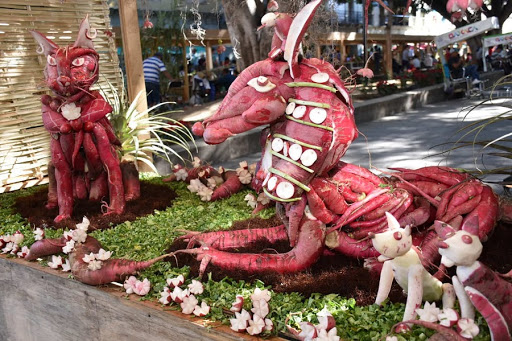
During the celebration it is customary to consume donuts and break the plates where they are served: depending on the number of pieces in which the dish is broken, it will be the fate of the diner for the following year.
The Night of Radishes is a traditional Oaxacan festival with a clearly popular stamp in which market gardeners and flower growers display the artistic talent of their hands with special designs made of radish, immortal flower and totomoxtle. The exhibition lasts only a few hours, but it brings together practically all the inhabitants of the city in the zócalo area, who attend in order to admire the creativity of the participants in this contest that takes place year after year on December 23.
Some authors mention colonial vegetable competitions, the friars (in particular the Dominicans) were the ones who taught the cultivation of flowers and vegetables, some brought from Spain to the groups of naborías (indigenous Zapotecs and Mixtecs) who served in the houses of the neighbors. On July 7, 1563, they were granted by order of Viceroy Luis de Velasco, the lands near the estates of La Noria and Cinco Señores, thus founding the town of Trinidad de las Huertas or de las Naborías. It was in this place that all the farmers dedicated to horticulture and floriculture were grouped.
Regarding its origin, various versions agree that the custom of radishes and their original designs have their roots in the Christmas Vigil market that was held precisely every 23 December.
The ancient way of Oaxacans was to attend the calendas and the mass of Gallo. Christmas dinner came much later. The merchants used to sell salty dried fish in the Plaza de Armas de la Vieja Antequera, essential for waking meals, as well as the vegetables needed to complement the menu. The market gardeners of Trinidad de las Huertas brought their vegetables, selling them in stalls set up for this purpose.
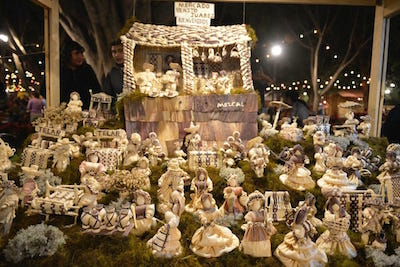
In order to make their stalls more attractive, the gardeners began to create figures with the radishes, adorning them with cauliflower leaves and flowers made from young onions. They placed radishes, lettuces, turnips, onions, etc., all in an artistic way, without forgetting the flower baskets, which were cultivated with care.
This habit was taking root, more and more with the passage of time, reaching a point that housewives looked for these figures to decorate their tables. According to reliable sources in the book “Noche de Rábanos” written by Professor Alejandro Méndez Aquino, it is known that on December 23, 1897, the then Municipal President, Don Francisco Vasconcelos Flores, organized the first exhibition in which horticulturists participated, exposing their unique and curious creations with radishes in the form of Christmas representations, people, animals, dances and other types of scenes that their imagination dictated.
At that time in the history of Oaxaca, the first outdoor exhibition of the Night of Radishes was held in the Plaza del Marqués or Plaza de las Armas, today Plaza de la Constitución. After the first floriculture contest, it became customary for it to be held year after year.
Some time ago two more categories were proposed; Immortal Flower and Totomoxtle; The Immortal Flower is a flower of the region that through a natural process dehydrates and with it a great variety of traditional figures and ornaments are made. The Totomoxtle is the shell or leaf that covers the corn; The leaf is also dried naturally and with them figures are made with motifs similar to those of the radish and the immortal flower.
DAY OF THE DEAD
The Day of the Dead is a Mexican celebration that honors the deceased on November 2, begins from November 1, and coincides with Catholic celebrations with the day of the faithful dead and all the saints.
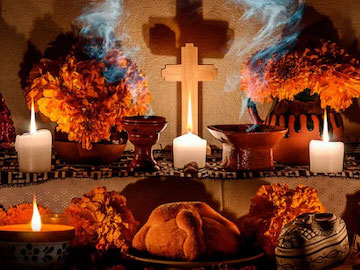
In this celebration it is customary to make Altars with offerings that is to say: Food, drinks, flowers that our deceased liked with images of the saints and photographs of them. placing candles to light his path; one of their beliefs is that a glass of water should be placed on it because the deceased arrive tired from their journey.
The celebration of the Days of the Dead in Oaxaca is a popular ceremony that invokes the spirits of the ancestors to invite them to “live together” in the earthly world, so they are treated in the most attentive way.
His visit among us obeys a permission obtained from the beyond so that the souls of the deceased can visit their relatives. The dead return home because they are attracted by their old belongings or by the love of their relatives.
It is possible to assure that no population of Mexico remains indifferent to such an ingrained tradition that in some way strengthens family ties by evoking the memory of loved ones.
There are vestiges of representations of death carried out by the various cultures that flourished before the arrival of the Spanish. These cultures maintained that with the cold winds from the north, the spirits of their dead came to visit them and to receive them they organized parties in their honor.
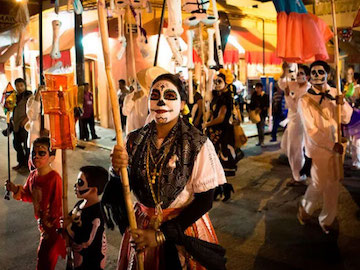
Since the evangelization of Oaxaca carried out by the Dominicans Fray Gonzalo Lucero and Fray Bernardino de Minaya, at the head of countless civilizing missionaries; The dates to celebrate the Faithful Departed were implemented, taking as a result of the cult of the dead that the aboriginal peoples already had and the prayers of the Church for the ancestors.
Currently, the celebration of the Dead begins in mid-October with the purchase of the products that will be placed as an offering on an altar. From very early on, the markets are installed and are dressed in characteristic smells and colors, then the gathering of relatives begins.
It can be found among the characteristic products of the season: black mole, Oaxacan sweets, among which canned pumpkin, manzanitas de tejocote and nicuatole, accompanied by chocolate and pan de muerto. All this and the fruits of the season are elements that are used to decorate the Altars of the Dead and to surround the offerings that are placed in honor of those who have already left this world.
The first of November is the day of “carrying the dead”, the custom consists in giving to relatives and friends of the family a gifted sample of the foods that make up the offering of the dead. Delivery is made house to house. This day the “little angels” are worshiped, that is to say, the relatives who died as children. On the second of November the deceased adults are venerated.
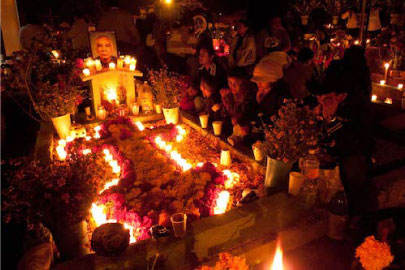
Celebration in pantheons
For all of the above, “Los Días de Muertos” represent a mixture of tradition, worship, festivity, magic and history in Oaxaca. It is a magnificent spectacle that is lived in the pantheons; such as the General Pantheon adorned with more than 2,400 candles, or what to say about the Contest of Altars of the Dead, the magnificent ornaments of the tombs, the ingenuity and dedication of the relatives to please the already deceased and all this expression of earthly love.
The City of Oaxaca is preparing for this meeting with the deceased, and in each one of the Pantheons there are activities that each one of us can share, live and experience.
Altars Cult
All Saints and the Faithful Departed are occasions for our people to exercise their ancestral customs. Some, praying for their past relatives, others going to cemeteries to decorate the graves that remain in the pantheons, thus preparing the ALTARS OF THE DEAD.
Much of the preparation of these festivals is reflected in the construction of the Altares de Muertos, an offering that is made to honor deceased relatives, since according to popular belief, they will come to visit their homes and their families on this day. . The Altars of the Dead are installed in the houses of their relatives or in the same pantheons on the tombs and vary according to the traditions of each region. Everything that the deceased enjoyed in life is remembered when preparing the altar; The offering is placed on October 31 in the morning, and it is everything that the relatives will come to savor and enjoy.
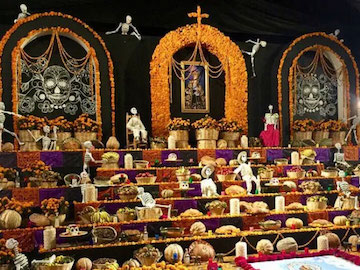
These altars are generally raised on a table lined with a tablecloth or a white sheet or with “chopped” china paper; On the front legs of the table, sugar canes or reeds are tied, which are given the shape of a triumphal arch, where the faithful departed are welcomed.
Traditionally, in all Altar de Muertos, one never forgets to place the flower of the dead, and the fragrant “cempasúchil”, and also flowers of another type. Another of the offerings that are never ignored and are placed on the altars so that the souls of the deceased are illuminated, is the lamp that contains castor oil, the white or yellow wax candles and candles. Depending on each family, religious images and photographs of the deceased are also usually placed.
From pre-Hispanic times to the present day, it has been customary among our peoples to place on the altar of the dead the offering of copal or incense, substances that, when burned, produce aromatic odors; This offering was considered one of the main tributes to the divinities.
Once the altar is placed, nobody can touch anything at all. The guests are the dead and it is they who initiate the treat, on their return to the underworld, already satisfied, they will only take away the smell and sap of the dishes, only after them, everything can be tasted by the relatives.
SAMARITAN WOMAN'S DAY
Samaritan Woman’s Day is celebrated on the fourth Friday of Lent, and tradition indicates that fresh waters and snow should be given on this day. Hundreds of stalls are opened with the flowers that Mexicans love so much and many colored ribbons, and the squares and public spaces are filled with people who want to participate in this tradition.
The waters are served from equally decorated pots and no one leaves without having taken at least one glass. There are no precise data on when this festival was instituted; some people assume that it was in the days of Christianization, although it is likely that it was in the late nineteenth century.
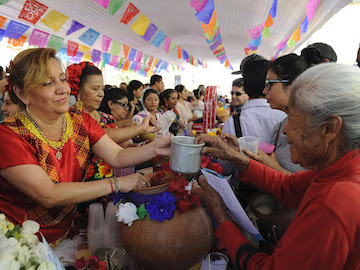
It is customary that in the morning of this Friday, in the temples, offices, schools, private houses and some companies fruit water is distributed to those who request it. In the temples it is carried out in their respective atriums and the water begins to be distributed once the priest has imparted the blessing.
Although it takes place in many churches in the city, we cannot say that this is an eminently religious festival, although it may have been in its origins.
It is said that this tradition possibly began when in the atriums of some churches of the Historic Center the representation of the biblical passage that referred to the encounter of Jesus with the Samaritan woman was performed. Various images were used for this, standing out the one that represented the Samaritan woman, dressed as Oaxacan Chinese.
The most typical flavors in La Samaritana are rice horchata, hibiscus, tuna, among others. Aguas Frescas are also prepared with chilacayota, a very fibrous type of squash that is grown in Oaxaca. The women wear their regional costumes during this beautiful tradition that represents the best of Oaxacan hospitality, courteous and gentle people who like to share with visitors.
It is currently considered a “typical” element of Oaxaca and its success lies in this Folkloric aspect, since the subjects want to participate in that image and contribute to its validity.
Another sample of the generosity that characterizes the Oaxacan people!
LAS CALENDAS
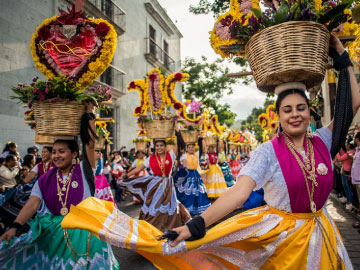
Las Calendas in Oaxaca, whose origin dates back to the 16th century, are manifestations where the population is invited to gather and celebrate great events. The patron saint festivities are distinguished by the calendas, which are also seen in other types of celebrations such as baptisms and weddings.
In the different towns of the Oaxacan entity, the calendas are carried out according to the tradition of each community, but it is distinguished by the parade of colors and shapes that invite family and friends to meet and celebrate.
The drum, the cohetones, the flowers and the joy of the attendees give life to the calendas, where children, youth, adults and the elderly participate.
TUESDAYS OF "BRUJAS"
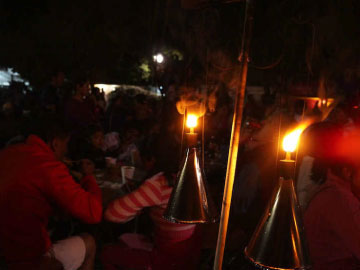
This tradition that according to the history of this town has its origins in the colonial era, when the friar Domingo de Santa María, promoted the construction of the Catholic Temple in which the natives of the population participated working night shifts, while the women prepared them bean tamales and atole sweetened with panela.
When the sun went down, the wives reached the edges of the trees, lit by ocote torches called “Brujas” (Witches), (currently they are containers made of tin with a lighter fueled by oil) where the sound of the snail announced dinner time, and all gathered as one family to share food.
In these times, the xoxeños relive the memories of the rich tamales of great women who inherited their seasoning to their descendants, who today offer tasty bean tamales, rajas, chepil, sweet, mole, the specialty of the house being the chichilo tamale.
Tuesdays of “Brujas” are held every Tuesday of the week after Ash Wednesday that marks the beginning of Lent, until Holy Week, it is a beautiful tradition in which you can enjoy very good concerts or dance while enjoying some delicious Tamales.
VELAS ISTMEÑAS
Las Velas Istmeñas originate from the Isthmus of Tehuantepec in honor of the local patron saint and are organized by one or more mayordomos supported by captains. Masses and parties are organized at the house of the butler and a parade in floats for the “fruit throw”, when the women of the Isthmus throw fruits and gifts to the spectators.
During the “Velas” celebration, the famous calendas are also held, where all the people go out to walk the streets, while they dance, sing and drink. All this is prior to the great dance dinner, where they will wear their Isthmian costume to show it off dancing to the sound of the Sandunga (Zandunga).
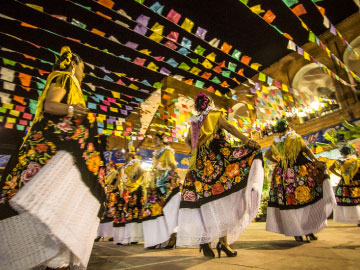
“May is the month of Velas”, they say; However, they are also held in other months of the year, especially on the days of the patron saints. What is a fact is that it has certain ritual steps that have few variations.
Between the Atlantic and Pacific oceans, the narrowest region of Mexico stands out, but whose cultural wealth is one of the most extensive in the country. It is the Isthmus of Tehuantepec whose folklore and traditions have gone around the world and are an example of Mexican cultural roots.
The Isthmus is rich in diversity, since it is inhabited by Zapotecs, Chontales, Huaves, Toques, Mixes, Mixtecos, Tzotziles and Chinantecos. Each of these ethnic groups arrived in the Oaxaca area in different periods, however, this heterogeneity allowed the Isthmus region to acquire an unequaled cultural wealth.
Origin of the “Velas Istmeñas”
Sheltered by complicity at night, one of the most emblematic traditions of this region stands out: the celebration of the “Velas Istmeñas”.
This tradition is full of religious syncretism, since it is carried out in honor of the patron saints of the different towns that make up the Isthmus and whom they honor with devotion during May.
This patronal feast has its origins in pre-Hispanic civilizations, who contributed a unique symbolism to each of the facets.
The “Velas Istmeñas” begin with a tour of the main streets of the city and that, generally, culminates in a church.
In this pilgrimage, the women wear the traditional and colorful Tehuana costume and the men a white guayabera and black pants; both walk accompanied by traditional music such as “La Sandunga”.
Symbolism of the “Velas Istmeñas”
The candle was adopted as the main component, since it is the representation of a sacred element for pre-Hispanic and religious cultures.
The candles were initially used as an offering to the divinities whom they thanked for good harvests, health and life.
However, before the conquest of the Spanish empire in Mexican territory, this tradition, like many others, was adapted to a celebration of saints.
The “Velas Istmeñas” combine in perfect synchrony many of the Mesoamerican offerings with the current customs that were derived from the miscegenation with the Spanish. That is why in some cases, the candle is offered to both a deity and a saint. In total there are 20 types of Velas that gracefully adorn the colors of the Oaxacan festival and, although Velas are celebrated in all the towns of the Isthmus, there are some that stand out in popularity.
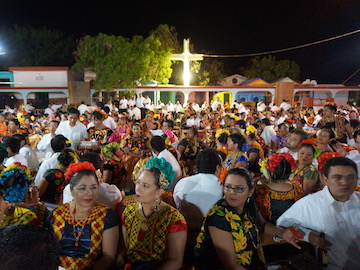
Vela San Vicente Ferrer. This Vela is carried out in Juchitán, it is carried out for the whole town and enjoys an incomparable splendor. The celebration includes a mass, a conviviality in the house of the butler, sprinkled with fruit, a bull run, fireworks, an evening and a popular dance. The big Vela of San Vicente Ferrer is celebrated the same night in different parts of the city.
Vela Santo Domingo de Guzmán. Its headquarters is Tehuantepec in honor of the town’s patron saint, the inhabitants perform dances, tours wearing traditional costumes and accompanied by the magnificence of the bands of the region.
Vela San Jerónimo Doctor. In Ciudad Ixtepec, the candle to San Jerónimo Doctor celebrates festivities offered by butlers, captains, captains and queens.
Vela San Juan. It takes place in the magical town of Espinal in honor of the patron saint San Juan and the Virgen del Rosario.
Vela Biaza. It celebrates the Zapotec resurrection, spring, and the nativity of the Virgin Mary.
Vela Bini. Dedicated to the goddess Centéotl and the Virgen del Rosario.
Vela Paloma. Offerings are made to Xochiquétzal, a maiden preparing for marriage, to midwives, in autumn, as well as to the Virgin of the Conception. “
Vela San Isidro. Represents the great social event for the Spring Festival, it is the feast of high society families.
Vela Cheguigo. The celebration of the Velas covers the entire region of the Isthmus of Tehuantepec, from north to south, therefore this candle is the one carried out by those who live on the other side of the river.
More Tourist Attractions in OAXACA
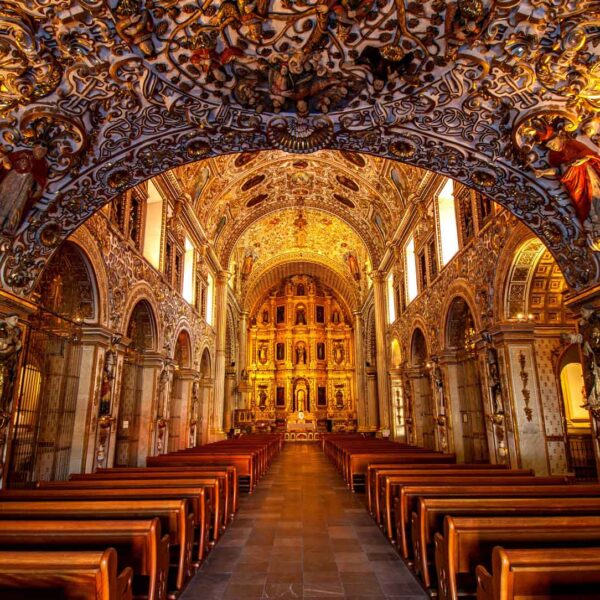
Santo Domingo Cultural Center
The Santo Domingo Cultural Center is a cultural complex that is located in what was one of the most important convents in the colony. It is a large convent in which the Museum of the Cultures of Oaxaca, the Fray Francisco de Burgoa Library and the Ethnobotanical Garden have been established. The Néstor Sánchez Public Newspaper Library is located in a building that is part of the complex but dates from the 19th century.… Read More
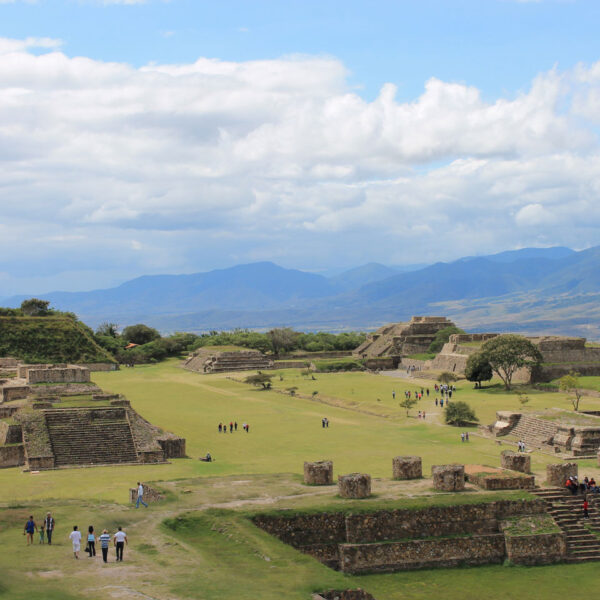
Monte Alban
Monte Alban is the most important archaeological zone of the Oaxacan entity, of unique regional importance due to the religious, political and economic control that the Zapotec state exercised over the population of the Valley of Oaxaca for more than thirteen centuries. It has been named by UNESCO Cultural Heritage of Humanity together with the city of Oaxaca on December 11, 1987. The heritage of the Zapotec world reaches us through the magnificent archaeological sites designed in the Valley of Oaxaca. Of these, the city of Monte Albán stands out for its enormous importance as an economic, political and religious hub (it was the first urban complex in Mesoamerica); by its extension, almost as big as the current capital of Oaxaca; and for its long life, started around 500 BC and concluded around 850 AD.… Read More
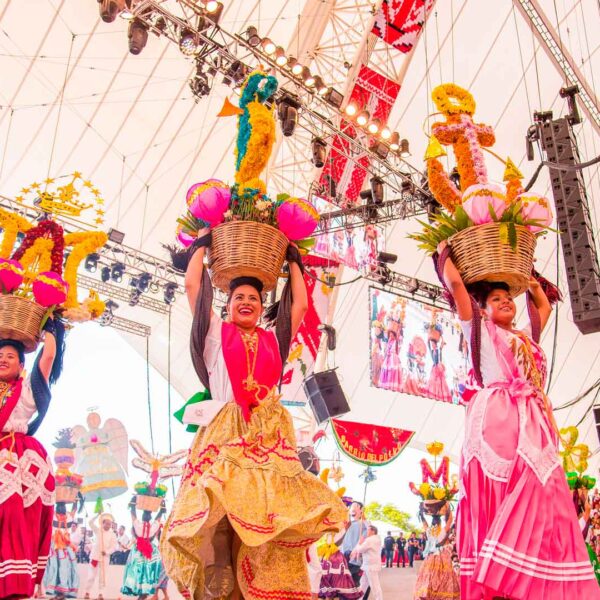
La Guelaguetza
The Guelaguetza is an ancient tradition with pre-Hispanic roots related to agricultural ceremonies of gratitude to the gods for the arrival of the rains and the lifting of the harvest at the end of July and is the largest festival in Oaxaca. La Guelaguetza is a celebration of gratitude for the arrival of the rains and the harvests, in which representatives from all regions of the state gather in the capital to share their culture through dances, crafts and food. La Guelaguetza is celebrated every year on the two Mondays after July 16, except when the first Monday is July 18, Benito Juárez’s death anniversary. Many types of dances also participate, such as the traditional Flor de Piña; where women usually dress in Huipiles representing the different regions of the state, as well as with their pineapple on their shoulders, they comb their hair with beautiful long braids accompanied by their ribbons and can not missing her accessories that is, bracelets, necklaces and earrings of precious colors and her beautiful makeup.… Read More

Mezcal
Mezcal is a rich, handcrafted flavored drink that requires considerable attention to be produced. Mezcal is normally served with white salt or worm salt (salt mixed with a cooked larva and ground chili), lemon or orange. Mezcal production today remains more or less as it was when the Spanish arrived hundreds of years ago. Each “recipe” is transmitted from generation to generation within the families that care about its production; Because each family has its own approach to mezcal production, there are an enormous number of different flavors. It is also in this way that the rich diversity of flavors and traditions are preserved for all to enjoy.… Read More

Beaches in Oaxaca
The beaches of the coast of the state of Oaxaca are among the most beautiful and complete in Mexico, thanks to a developing tourist infrastructure and the rich gastronomy of the Pacific. Along the 533 kilometers of coastline, the beaches of Oaxaca offer a wide variety of activities for lovers of water sports: snorkeling, diving, sport fishing, surfing, among others… there is something for everyone!… Read More
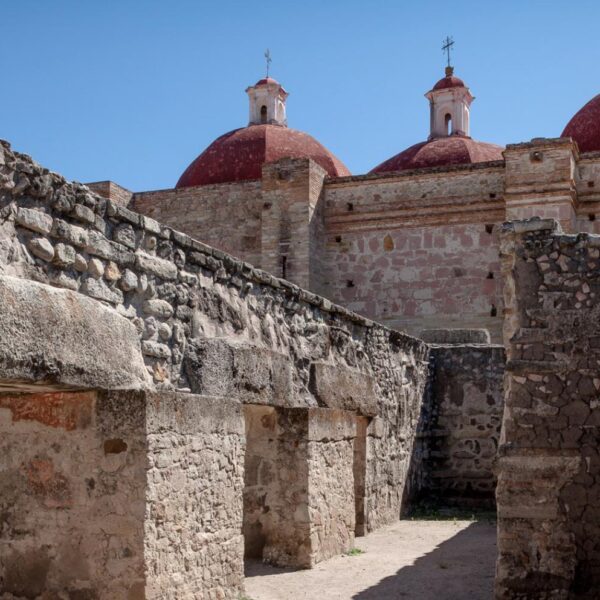
Archaeological Sites in Oaxaca
Oaxaca is famous throughout the world for its archaeological sites and the history they keep. Discover Monte Alban, Mitla, Yagul and more of these remote sites, which have made Oaxaca a World Heritage city, according to Unesco. The original Zapotec and Mixtec peoples of Oaxaca lived in the cities and religious centers of the valley of this city until the time of Spanish colonization. Today, there are still vestiges of these towns and places where you can meet them.… Read More
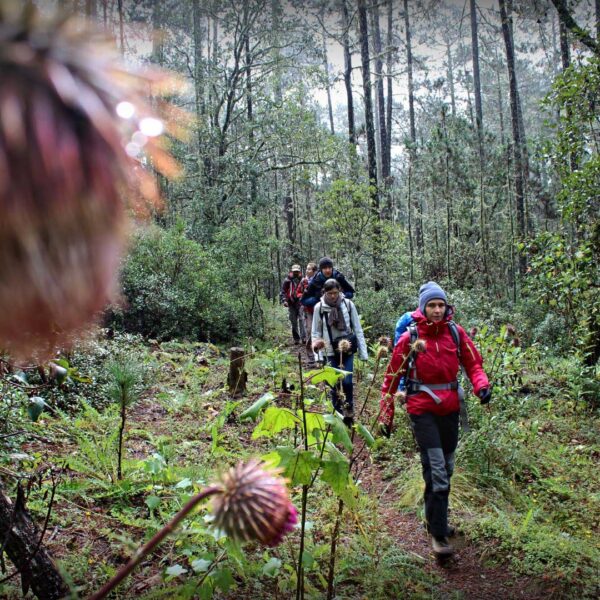
Ecotourism and Adventure in Oaxaca
Oaxaca, located in the southeast of Mexico, is an example of a singular miscegenation that even in the midst of modernity never forgets its origins. In its varied geography, it brings together not only a vast biodiversity, considered among the largest in the world, but also insurmountable cultural and ethnic riches, and the most different and beautiful natural settings. An ideal space for Alternative Tourism, Oaxaca offers activities such as walking, mountain biking, rappelling, climbing, zip-lining, horseback riding, observation of flora and fauna and more, in close contact with nature. The visitor can also witness the various aspects of local life, savor the gastronomy and enjoy the warmth of its people, as well as an offer of accommodation in hotels, ecotourism cabins, local houses or excellent camping areas.… Read More
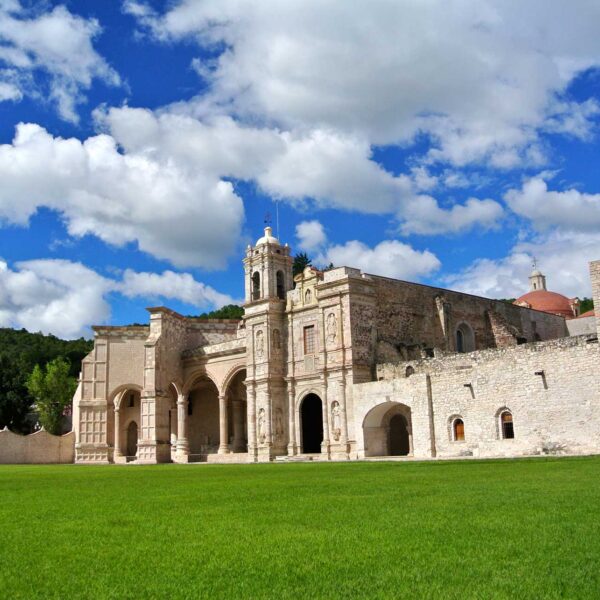
Magical Towns in Oaxaca
In Oaxaca we are proud to have 5 communities that have been awarded the title of Magical Towns of Mexico, a Magical Town is a town that has symbolic attributes, legends, history, transcendent events, everyday life, in short magic that they emanate in each of their socio-cultural manifestations, and that today mean a great opportunity for tourist use. The Magic Towns Program contributes to revalue a group of populations in the country that have always been in the collective imagination of the nation as a whole and that represent fresh and different alternatives for national and foreign visitors.… Read More
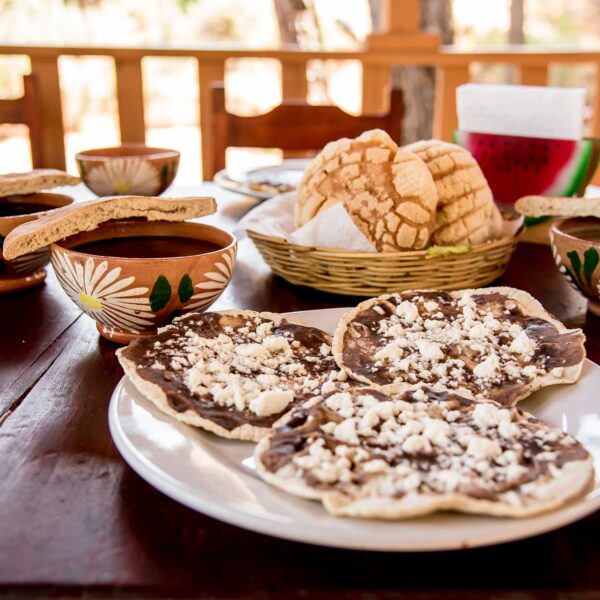
Gastronomy of Oaxaca
The Oaxacan gastronomy takes you on an amazing journey into one of the most outstanding and colorful cuisines in the world. Oaxacan food is among the most varied and delicious in Mexico, UNESCO has declared it Humanity’s Cultural Patrimony. Oaxaca’s gastronomy incorporates elements of pre-Hispanic cuisine, and lively imagination has created combinations that amaze by the color, the aromas and the flavors.
The list of dishes that characterize this cuisine is endless, however, we can mention: Oaxacan Mole in its 7 varieties depending on the type of chili used, Chapulines, (dry roasted, spiced grasshoppers), tlayudas (large tortilla spread with the remaining of the lard and beans), maguey worm sauce, chiles rellenos (stuffed chilies), and of course the famous Oaxacan tamales in banana leaves. Oaxaca cheese is a soft white string cheese, which is similar to mozzarella. It is sold in “ropes” which are wound onto themselves into balls, and eaten cold or lightly melted on quesadillas is considered among the best in the world.… Read More
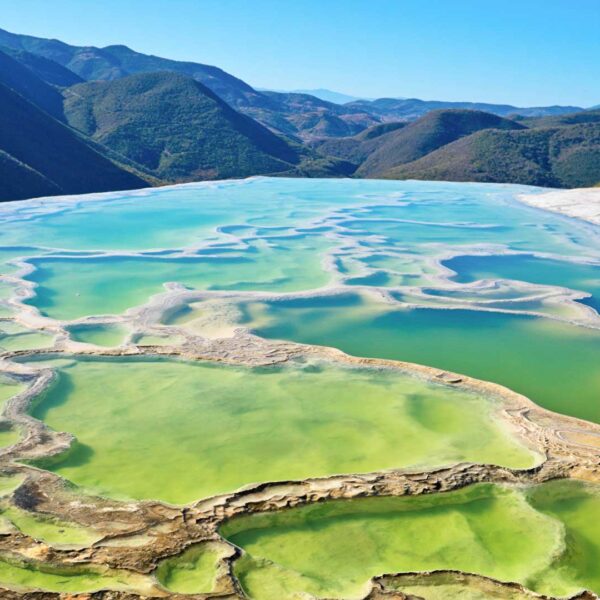
Oaxaca City Surroundings
Oaxaca is a destination that offers a great variety of attractions and tourist charms which leave anyone surprised. When arriving in the city of Oaxaca, the most common is to visit the historic center, the Santo Domingo Temple, the Macedonio Tourist Walk, the gastronomic delights in the Benito Juárez market, the Basilica de la Soledad, among other attractions. And one of the places that you cannot miss is the Monte Alban archaeological zone, which is approximately 30 minutes by car from the historic center. However, there are other places that are also worth knowing and are in the surroundings of the city. For this reason we recommend the following tourist routes.… Read More
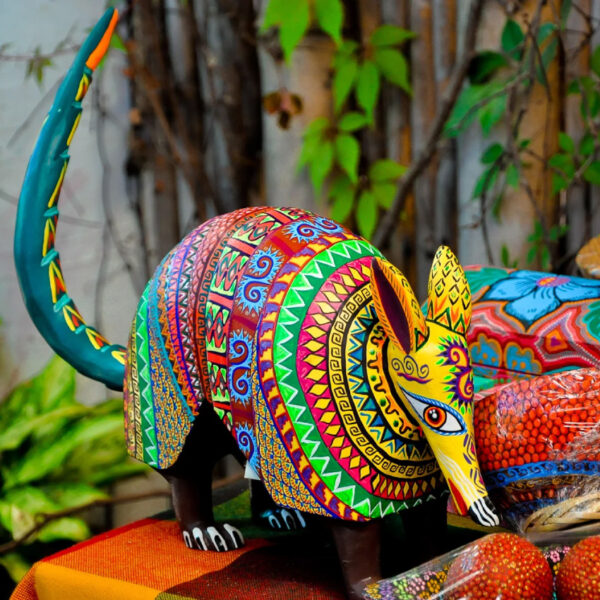
Handicrafts from Oaxaca
Handicrafts from Oaxaca are a great tradition and they offer a diversity that denotes the artistic richness and imagination of its people. The talented artisans of Oaxaca make beautiful pieces of clay, textiles, wood, metal, skins and other materials, forming a rich and varied folk art in both decorative and useful items.… Read More
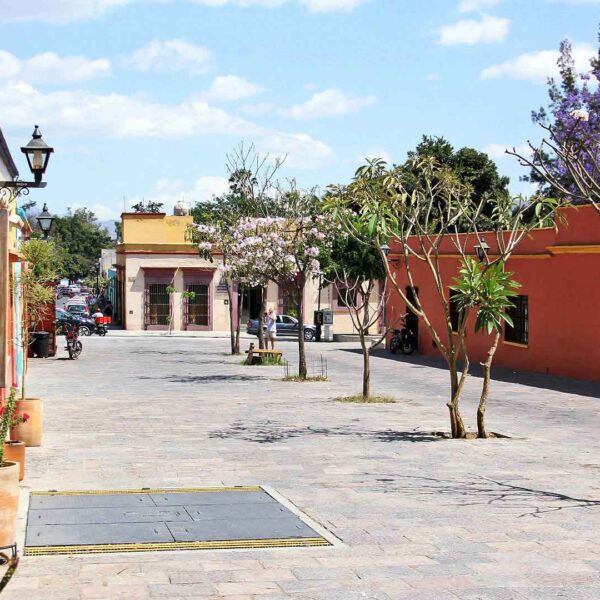
Oaxaca City
Oaxaca is the most diverse state in Mexico. It has peaks that reach more than 3,000 meters high, caverns that are among the deepest in the world, virgin beaches, secluded forests, and sunlit valleys. Oaxaca is rich in traditions and customs and has the largest ethnic population found in Mexico.
The City of Oaxaca, the state capital, is famous for its architecture and for its rich cultural traditions. Oaxaca is also graced by a splendid and varied cuisine and spring-like weather year round. UNESCO declared the city a Cultural Heritage Site.… Read More
Guided Tours in OAXACA
Flights & Hotels in OAXACA
More Tourist Attractions in MEXICO

Magical Towns
A Magical Town is a place with symbols and legends, towns with history that in many cases have been the scene of transcendent events for our country, they are places that show the national identity in each of its corners, with a magic that emanates from its attractions ; visiting them is an opportunity to discover the charm of Mexico. The Magical Towns Program contributes to revalue a set of populations in the country that have always been in the collective imagination of the nation and that represent fresh and varied alternatives for national and foreign visitors. A town that through time and in the face of modernity, has conserved, valued and defended its historical, cultural and natural heritage; and manifests it in various expressions through its tangible and intangible heritage. A Magical Town is a town that has unique, symbolic attributes, authentic stories, transcendent events, everyday life, which means a great opportunity for tourist use, taking into account the motivations and needs of travelers.… Read More

Beaches
On the Beaches of Mexico you can immerse yourself in the intense blue ocean of the Pacific bays, sunbathe on the shore of the warm and transparent waves of the Caribbean Sea in Quintana Roo or even rest on the beautiful coasts of the Gulf of Mexico. Mexican beaches hide wonderful secrets for the traveler. By visiting them, in addition to enjoying the excellent climate and water activities, you can discover splendid archaeological sites and interesting colonial cities without traveling long distances.… Read More

Ecotourism and Adventure
Mexico is one of the best countries for Ecotourism as it has a great variety of flora and fauna, as well as a large number of refuges for extraordinary species. You can enjoy recreational activities of appreciation and knowledge of nature through contact with it, such as: stargazing, observation of natural attractions, wildlife and bird watching. Throughout México there are more than 176 protected natural areas, 5 of them considered by UNESCO as Natural Heritage of Humanity. Just for this and much more, we believe that Mexico is a Paradise for Ecotourism.… Read More

Capital Cities
Folklore, gastronomy, literary culture, art and exhibitions, is what you will find in the capitals of the states of Mexico. To the north, colonial Mexico, Puebla, Guadalajara, Guanajuato, the Sonoran desert and the California peninsula. To the east Veracruz and the gulf. To the west Acapulco, Oaxaca and Tuxtla Gutiérrez. And to the south the Riviera Maya and the pyramids of Chichén-Itzá, Tulúm and Cobá in Yucatán, Palenque in Chiapas, the cenotes, and the Central American jungles.… Read More

States Of Mexico
Mexico has an incredible diversity of landscapes, where the beauty of its beaches, internationally recognized, stands out. In its vast territory of coasts, there are beaches of unparalleled beauty, and colorful landscapes. A large network of first-class hotels and tourist services is available to visitors to these beaches. Mexico is also mystical places, dotted with archaeological testimonies inherited from its original inhabitants. Monuments made by the Mayas, Aztecs and Toltecs are located in magical landscapes, like lighthouses in an ocean of natural beauty. They offer visitors buildings that tell their history, and museums that collect their cultural heritage. And that keep alive ancestral traditions, in ceremonies and festivals, where you can enjoy cultural activities and entertainment.… Read More

Archaeological Sites
The Archaeological Zones are the cultural past of every Mexican. You will be amazed at the ambient, nature and the environment that surrounds them. Climbing to the top or being around it will take us back in time to admire every detail. México is a country of culture and traditions, many of which we have inherited from the pre-Hispanic inhabitants of this vast territory, although it is true that there were more settlements in the central and southern part of the country, it is also possible to find some archaeological remains in the north.
… Read More

Traditions in Mexico
It is practically impossible to make a meticulous, and above all, accurate selection of the places to visit in Mexico. Each place that our country houses is unique and beautiful in its own way. Mexico, with its nearly 2 million km², has a large number of scenarios to offer, as well as endless activities to do. Do not lose your way and enter the places to visit in Mexico. In Mexico, apart from the beaches and its famous archaeological sites, there are many other really interesting sites and activities that you should know. In the surroundings of the main cities you will find places full of culture and tradition, where you can spend relaxing, interesting and fun vacations. On your trip through Mexico you cannot stop obtaining souvenirs, the crafts that are made here are of the highest quality and recognized worldwide. A shopping tour cannot be missed.… Read More

Gastronomy
The Gastronomy of Mexico has a great diversity of typical dishes, which is why it was recognized by UNESCO as Intangible Heritage of Humanity. The basic and representative ingredients of Mexican dishes are: corn, coriander, chili, beans, piloncillo, nopal and tomato. Mexican cuisine is also characterized by its sauces, which serve as an accompaniment to traditional dishes, prepared based on spices.… Read More

